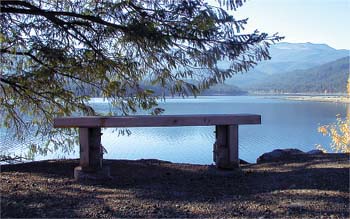All Issues
Service grants allow 4H-ers to build healthier communities
Publication Information
California Agriculture 62(1):6-7.
Published January 01, 2008
PDF | Citation | Permissions
Full text
On the morning of a school holiday in mid-November, 12–year-old Sean Boerger got a ride across town and presented his ideas for installing benches in a wetland to officials of the Siskiyou Land Trust. Boerger is junior leader of the Strawberry Valley 4–H woodworking group, and he knows about making and installing public benches. Last year, his group won a 4–H service-learning grant to provide benches at Siskiyou Lake. This year, a new grant of $1,100 will allow the group to make benches for the Sisson Meadow Wetlands, which the land trust has recently restored in downtown Mt. Shasta.
“I think it's going to be fun for the group,” Boerger says. “The benches will give people a place to sit and make the area look nicer, and we get to learn more woodworking skills.”
That's exactly the concept of service learning — serving the community and, in the process, gaining educational opportunities. Last year, the community of Lake Siskiyou received beautiful, sturdily built benches, and Boerger and his group learned many things, including how a cedar snag is felled and turned into lumber at the town mill. On the new project, Boerger is looking forward to the trickiest aspect: “I'm not quite sure how we're going to do the foundation, because it's kind of swampy out there,” he says.
The service-learning grants are part of the California 4–H Youth Development Program sponsored by the University of California Division of Agriculture and Natural Resources (the 4 H's stand for “Head, Heart, Hands and Health,” and members pledge their hands to “larger service").
Strawberry Valley 4–H Club With support from a 4–H service-learning grant, the Strawberry Valley 4–H woodworking group built and installed benches at Siskiyou Lake.
“The goal,” says Pat English, California 4–H program representative, “is to expand members' skills in citizenship, leadership and life.” Citizenship has three definitions: who or what we are, what we believe, and what we do, English explains: “The service-learning projects provide teachable moments, opportunities for reflection and the means to gain experience in community building.”
This is the fifth year California 4–H service-learning grants have been awarded; distributions have ranged from $5,500 to $14,900 per year and are a gift from the Thomas and Dorothy Leavey Foundation. Proposed projects must contain aspects of community service and education; address significant environmental, economic and/or social issues affecting California's youth, families and communities; and involve collaboration with other community-based organizations.
Grants for four other service-learning projects were awarded in 2007. Another Siskiyou County 4–H group received $1,000 to organize a “senior prom” for elderly residents. In Sacramento County, a 4–H club has $2,000 to provide environmental education and outdoor living experience to 1,000 elementary students from economically disadvantaged neighborhoods. In San Mateo County, members of the Belmont 4–H Clothing Project were awarded $233 to create dyed-silk scarves for a local hospital. Also, $500 of seed money was awarded for surely the most ambitious youth service-learning idea ever, the 4–H Million Trees project.
The Pacifica 4–H club is developing plans to plant a million trees across the United States to combat global warming; their estimated budget for the project is $1 million. High-school freshman Laura Webber saw Al Gore's An Inconvenient Truth with her father last winter and was galvanized to do something; she and the other club members worked out the details.
Although the Pacifica group will plant some trees, the aim of the project is to enlist the help of the 90,000 other 4–H clubs in the country, a total of 7 million youth. Each club has to plant only 12 trees to achieve the goal ( http://www.4hmilliontrees.org ).
Engaging in public projects that serve the community, or the whole world, in tangible, recognizable and important ways motivates young people ( see page 40 ). The projects inspire their adult leaders also. Todd Ellorin, the Siskiyou Woodworking project leader says, “These kids want to know where the lumber is coming from and how the project affects the environment. I really learn from them.”
The Siskiyou Land Trust listened to Boerger's new bench ideas “and made some changes,” Boerger says. Ellorin says he will discuss with the group a way to respect the client's wishes and also try something new. That's another skill that's definitely useful for the adult world.





